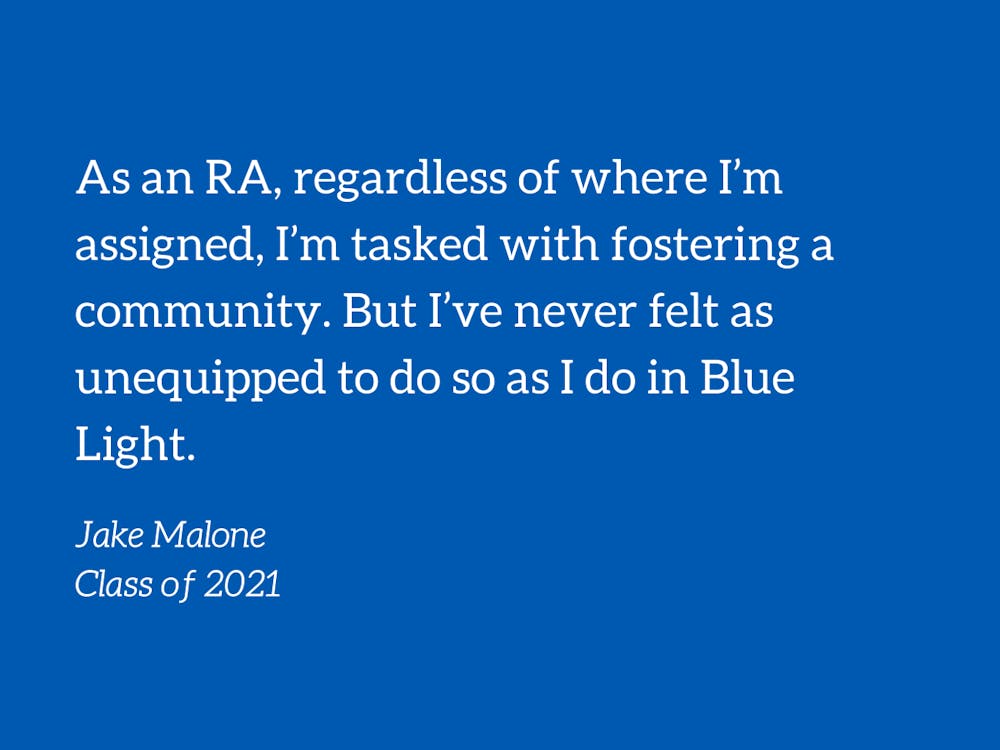Have you ever wished that you could live on campus and off campus at the same time? Have you ever found yourself thinking, “Man, I sure would love to live in the antithesis of Bassett right now”? Do you want to swim in the world’s most underwhelming rooftop pool? Look no further than Blue Light Living.
Blue Light Living sits on the corner of Erwin Road and West Pettigrew Street, over the once-holy grounds of Sam’s Quik Shop, a craft beer store that had served Duke students for decades. You can catch Blue Light looming in the distance as you stroll down Ninth Street to grab your lunch. It’s menacing, and now it’s my home.
When Duke HRL decided to convert all dorm rooms to singles, they very quickly realized that there just wasn’t enough space. “But soft!” they declared. “There is but one solution!” And with a snap of their infinity gauntlet, Blue Light was added to the Duke bubble.
The problem? Blue Light is not a dorm. But we’re trying to pretend that it is.
Students assigned to Blue Light aren’t getting the on-campus community experience. They don’t have a bench to paint, a laundry room to complain about, or a Wii in the common room. Even if living on campus feels completely different this year, you can still mingle with people in Duke’s commons rooms while playing ping pong—the perfect sport for social distancing.
Blue Light’s website defines itself as a “student housing community,” but a building doesn’t become a community just because it’s marketed as one. The granite countertops, faux-wood floors and floor-to-ceiling glass windows makes each of Blue Light’s apartments feel more like a hotel room than a dorm room. Swap it out with any other gentrified complex in the Durham area and I wouldn’t know the difference. Like Moby Dick’s white whale, its purity is unsettling.
Over time, each of Duke’s on-campus residence halls developed their own reputations and personalities. People living in Alspaugh or Bassett know that dorms don’t age all too well. Kilgo residents rave about their ice cream parties and prime campus location. Living in Trinity became many freshmen’s sole personality trait.
So what’s Blue Light’s personality? It’s clean? It’s empty? It’s still being built?
Honestly, the place just doesn’t have a personality yet.
I moved into Blue Light without any of my belongings. The pack/store/ship option forced me into a pre-furnished apartment without all the personal touches that made my previous dorm feel like home. It was then that I ran into a dilemma when I received my dorm decor: should I even put them up? Did my collection of movie posters, art prints, and tapestries even belong anymore?
Being a student in Blue Light is weird. But being an RA in Blue Light is even weirder.
Getting to be an RA on East Campus has been one of the most fulfilling parts of my Duke experience. I was able to bond with each of my residents naturally through our many small encounters. We shared a staircase, and would share our woes as we trudged up to the third floor at the end of a long day. By the spring semester, my group of residents let me decorate each of their doors with my own face (a choice I will never regret). The community I helped to build in Alspaugh arose thanks to the chemical mixture of overly-eager freshmen, one cramped, creaky building, and a team of RAs who truly cared about their residents.
But Blue Light is an entirely different beast for an RA to face.
While Duke leased around 45 of the building’s apartments, the rooms are scattered among all six floors, preventing any one common space from really feeling like a Duke space. 300 Swift faced a similar problem after Duke bought the apartment complex in December 2016. Carly Bandt, one of Swift’s first official Duke student residents, told The Chronicle in fall 2017 that the building lacked the sense of community common to typical on-campus dorms.
“It’s sad thinking that they have essentially no dorm community here,” she said. “I barely even know my neighbors.”
Avana, like Blue Light, now faces similar barriers to community as an apartment complex without a Duke-specific reputation. But unlike Blue Light, Avana’s only residents are Duke students, living under the omnipotent rule of HRL. It may be located further from campus than Blue Light, but its buildings are filled with Duke furniture and its walls adorned with posters of the RA-on-call number. As an RA in Blue Light, the first week of on-call nights was characterized by asking myself, “Is the room throwing the party a Duke room? Or just a room?”
In order to take the leap into RA territory that only 300 Swift has known, I have to let go of my East Campus view of community. I cannot expect Blue Light’s residents to suddenly start becoming best friends while chatting on the common room couch, when the privacy and comfort of their own fully-furnished apartment is down the hall. It’s just not realistic.
As an RA, regardless of where I’m assigned, I’m tasked with fostering a community. But I’ve never felt as unequipped to do so as I do in Blue Light. Frankly, I don’t know if it’s possible. Before my residents can respond to my attempts at community building, they have to respond to my emails.
Jake Malone is a Trinity senior who just wants to know if his residents are still alive. Seriously. Just give me a sign. His column runs on alternate Fridays.
Get The Chronicle straight to your inbox
Signup for our weekly newsletter. Cancel at any time.

